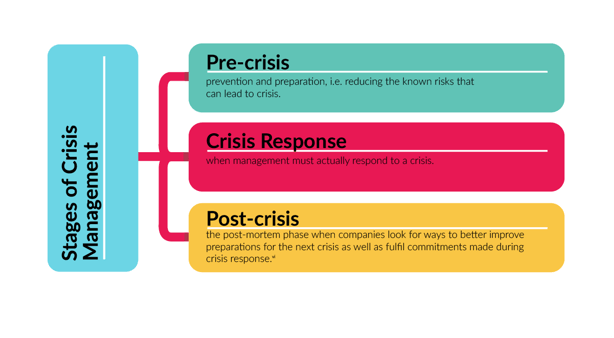Understanding Crisis Management
Once upon a time, crises were sporadic. Not anymore. Crises are now consecutive, concurrent, and compounding. What’s more, they’ve become progressively costlier to recover from. As such, crisis management has become more important than ever. And so, this article marshals expert guidance to relate the key benefits and approaches to crisis management.
What is Crisis Management?
So, what is crisis management? Dating from the 1980s, crisis management is the practice of and process by which an organization deals with disruptive and unexpected events (also known as crises) that threaten to harm it and/or its stakeholders.
Why’s a formal practice needed to manage crises? Besides their threat to a business’s core objectives, reputation, even viability, crises, once underway, don’t just burn bright, then suddenly extinguish.
Instead, crises have become increasingly multilayered and multidimensional in this business environment. And so, to properly prepare for, manage, and recover from crises, companies need a strong crisis management function. Such a function must first be capable of anticipating crises.

The Crisis Management Cycle
Anticipating crises suggests that there are stages of crisis management, besides response and recovery. Indeed, there’s a full crisis management life cycle.
What are the stages involved in crisis management? The basic stages include:
- Pre-crisis. As the name implies, the focus at this point is on prevention and preparation, in other words, reducing the known risks that can lead to crisis.
- Response. Now, you’re in the thick of it. This stage deals with the actual response to a real, live crisis.
- Post-crisis. All great crises must come to an end. But that doesn’t mean they won’t reoccur, especially if companies don’t undertake this final, post-crisis stage. During this phase, companies will take the opportunity to look back and reflect. They create a post-mortem to see what went wrong, which helps them think of ways to better prepare for the next crisis. It’s also when companies begin fulfilling the commitments they made while the crisis was still raging.
Understanding that beginning, middle, and end-framework to the crisis management life cycle is just a start, though. A crucial start, but a start all the same.
That’s because the stages of crisis don’t break down that neatly. Advanced crisis management techniques rely on a more strategic, cyclical lifecycle approach. Here follows one formulation of the crisis management life cycle:
- During the first, build up stage, you’ll see hints of a potential crisis brewing, often on social media. At this point, you should be looking for certain repeat messages that foreshadow crisis.
- By the impact stage, that earlier trigger has now morphed into a full crisis. You should expect to get the most media scrutiny at this point. But it’s not over yet…
- Because during the chronic crisis stage, the media usually shifts the script from what’s happening to who’s to blame. Meanwhile, a crisis-sieged company is still suffering through the effects of impact, which can be as significant as physical restoration.
- Eventually, you’ll get to the resolution stage when the crisis-hit company is up, running, and (hopefully) out of the media glare. But if this stage doesn’t include deep analysis and investigation, that company is basically just biding its time, waiting for the next crisis to strike.
The Crisis Management Plan
How then to go about preparing for increasingly multilayered and multidimensional crises? That’s where the crisis management plan comes in. What is a crisis management plan? And what’s involved in crisis management planning?
Taking the second question first, crisis management planning is about proactively assessing and addressing vulnerabilities to avoid or minimize the impact of crises.
One way to think of crisis management plans is as the set of processes that crisis management teams (in coordination with other, relevant business units) put in place before a crisis strikes, to manage the effects.
Distinct within the overall crisis management process, crisis management planning deals with contingencies and scenarios, especially those most likely to occur in your line of work (e.g., a data breach at a digital retailer or a bushfire in an at-risk region).
As to what should be in your plan, the typical crisis management plan will incorporate emergency response, crisis communications, as well as the steps crisis management teams should take to trigger an official crisis.
Crisis Management Apps
The benefit of crisis management planning is not just that your organization will be better equipped to effectively respond to specific incidents. There’s also value in going through the process of crisis management planning to identify other potential threats and game out the tasks, processes, and crisis management software you’ll need throughout the crisis management life cycle.
How does a crisis management app help, here?
Well, a crisis management app can improve incident plans with best-practice libraries to create crisis strategies easily and action plans for different types of events that define the required strategy, action items, completion time targets, and people involved.
Within those solutions, you can create plans, playbooks, and checklists to quickly activate and dispatch your teams. Further crisis management planning capabilities that you can derive from certain best-in-breed vendors include:
- Provide clear instructions on what each person’s roles and responsibilities are in an event, and what tasks they need to complete
- Use out-of-the-box plan activation workflows to speed up incident response
- Automate and track task allocation and status
- See plan progress at a glance, create and assign tasks on the fly, and stay aware of any blockages or delays
- Ensure all your important documents, procedures, and other critical files are always at your fingertips
But, of course, that’s not the only thing crisis management solutions are good for. Learn more about Noggin for Crisis & Incident Management.




